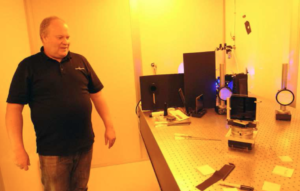By Kevin Opsahl | Posted: Thursday, January 16, 2014 8:58 pm
The Herald Journal
A Logan-based company is developing technology that will be used to help find traces of organic material and water on a mission to Mars tentatively scheduled for 2018.
 The optical imaging company Wasatch Photonics, located at 1305 N. 1000 West, will create volume phase holographic gratings for an instrument that will be used in the ExoMars mission. The Madrid-based Instituto Nacional de Tecnica Aeroespacial, a public research organization, is developing the instrument that will be used for the European Space Agency-led mission.
The optical imaging company Wasatch Photonics, located at 1305 N. 1000 West, will create volume phase holographic gratings for an instrument that will be used in the ExoMars mission. The Madrid-based Instituto Nacional de Tecnica Aeroespacial, a public research organization, is developing the instrument that will be used for the European Space Agency-led mission.
Wasatch Photonics got involved with the project through its work with a European astronomy company called FRACTAL S.L.N.E.
Gerald Heidt, president of Wasatch Photonics, said this is a project that sets itself apart from others the company has been involved with. “I think it’s great; when I learned about (the Mars mission project) I was all for it,” he said. “Anything that goes into outer space is unique — but to go to another planet? I never thought that would be happening until this year.”
 The possibly of finding natural resources on Mars is exciting, Heidt said, because it could lead to a manned mission to the Red Planet in the future. CBS News reports that U.S. experts believe a manned mission is possible by the 2030s.
The possibly of finding natural resources on Mars is exciting, Heidt said, because it could lead to a manned mission to the Red Planet in the future. CBS News reports that U.S. experts believe a manned mission is possible by the 2030s.
“There have been a number of missions to Mars where rovers have mapped out the planet, so they really have a good idea of where they might find water and life — but they have no way to determine that,” Heidt said. “Now we’re sending something up there that will be able to determine if their theory is correct. This is next step. I think it’s important that we’re helping on this next important mission.”
A grating is an optical device that diffracts light into its component frequencies in the spectrum. Wasatch Photonics will manufacture 38 of them for the mission to let the agency test which ones will work. But only one grating will be used on the instrument.
Here’s how the instrument, called the Raman spectrometer, will work: Once on Mars’ surface, a drill in the ExoMars rover will collect samples as deep as 2 meters beneath the Martian surface. The samples will be crushed into a fine powder and studied inside the rover’s analytical laboratory.
“The Raman laser spectrometer will analyze these samples, obtaining information about their mineralogy and chemical composition, and detect possible organic compounds,” Heidt said. “But the thing that really makes this doable is the grating is going to disperse the light from the sample, and separate the unique pattern of the spectrum that each molecule has — like a fingerprint … and tell you what the makeup of the sample is.”
Founded in 2002, Wasatch Photonics is a designer and manufacturer of optics technology for astronomical, defense and medical applications. The Logan-based company also has locations in Research Triangle Park in North Carolina and Purdue Research Park of West Lafayette, Ind.
Read more about it here: http://www.ksl.com/?sid=28372422
kopsahl@hjnews.com
Twitter: KevJourno
Update on ExoMars
It was ultimately decided not to include Raman spectroscopy on the ExoMars 2016 mission. Raman spectroscopic analysis of samples collected from Mars’ surface will be included however, in the ExoMars 2022 mission, which is expected to use a spectrometer based on a Wasatch Photonics grating. For updates on this mission, subscribe to our newsletter!


